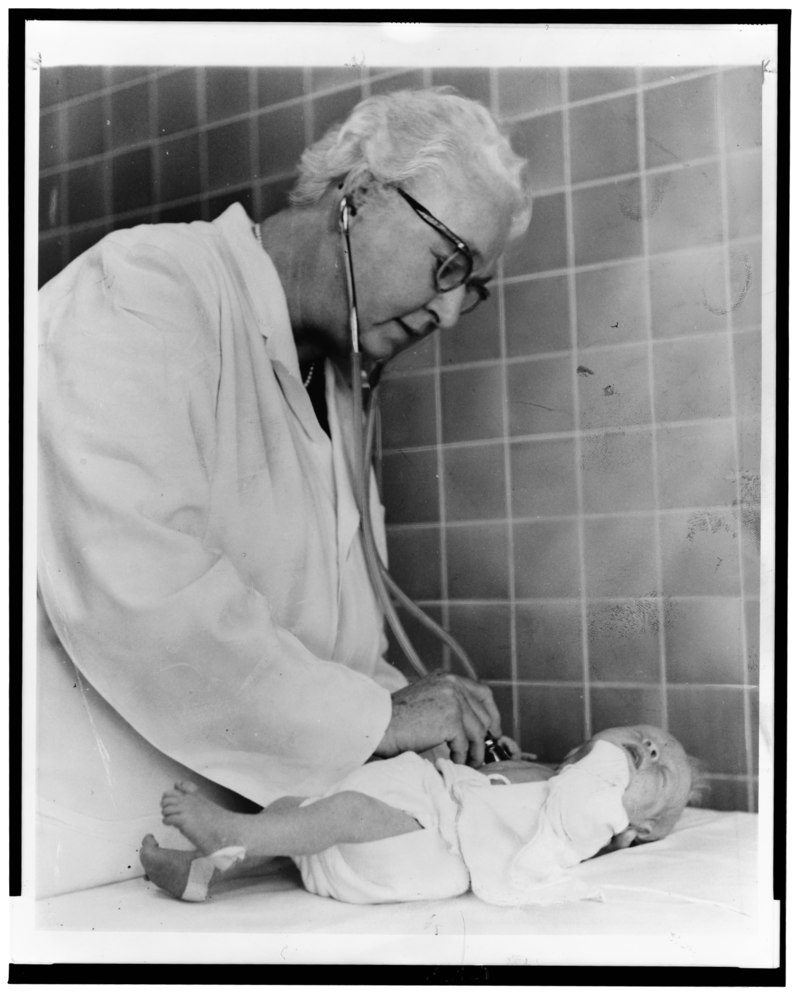Since ancient times, women have practised medicine, even if, as was the case with Agnodice in Athens in the 4th century BC, they had to disguise themselves as men in order to do so. During the 10th century, women were not forbidden to enter medical school and figures such as the Ladies of Salerno appeared, including Trotula of Salerno, who was able to practise and write on medical subjects under her own name. Later, women were once again barred from medical studies until Elisabeth Blackwell gained entry to medical school, becoming the first woman to graduate in medicine in the United States in the 19th century. Virginia Apgar belongs to a tradition of women - including Hildegard of Bingen - who have practised medicine with extraordinary brilliance, sometimes against their own time.
Virginia Apgar was a contemporary of Jenny Rosenthal Bramley, a Russian physicist, known for being the first woman to obtain a doctorate in physics from an American institution, and of Rita Levi-Montalcini, the physician who discovered the first known growth factor in the nervous system.

Virginia Apgar
New Jersey, 07-06-1909 — New York, 07-08-1974
Periodo de actividad: 1938 — 1973
Clasificación geográfica: América > Estados Unidos
Movimientos socio-culturales
Grupos por ámbito de dedicación
Sanitarias > Médicas
Contexto de creación femenina
Reseña
Among his achievements, we can highlight the Apgar test, which is still used today to make an initial assessment of the state of health of newborns and to detect possible illnesses. He discovered that the anaesthesia called cyclopropane, administered to women in labour, had a negative effect on the health of the baby, so thanks to his discovery it was no longer used in childbirth. Also notable is his advocacy of universal vaccination to protect the babies of infected mothers during the rubella epidemic of 1964-65. In that epidemic, there were 12 million cases and 20 000 congenital syndrome and affected babies.
Actividades
Justificaciones
Biografía
Virginia Apgar was the youngest of three children born to Charles E. Apgar, an insurance man, and his wife, Helen May Apgar. She graduated from Westfield High School in 1925, and went on to Mount Holyoke College, where she majored in zoology while working odd jobs to pay her way through school.
He studied medicine at Columbia University.
After graduating, he began a surgical internship at New York Presbyterian Hospital. Despite her great abilities, her mentor, Allen Whipple, advised her to pursue a speciality in which the situation of women was not as precarious as in the world of surgery. Thus, Virginia began studying anaesthesiology. In 1938, Virginia Apgar graduated and returned to Presbyterian Hospital as director of a new division of anaesthesia, making her the first woman to head such an important team. During her eleven years at the helm, she devoted herself to training students and developing the anaesthesiology division into a professionalised service. However, when this happened, a man, Enmanuel Papper, was appointed director of the service.
It was then that she joined Columbia University as Professor of Anaesthesia, and became the first woman to do so. At this time, she began to devote part of her time to research in the field of obstetric anaesthesia. She wanted to detect the reasons for premature neonatal deaths. His analyses became, in 1952, what would become known and applied worldwide as the Apgar test. For almost ten years he analysed and classified thousands of births he was present at in order to narrow down his test. With this test, five aspects of the newborn are evaluated: heart rate, breathing effort, reflexes, muscle tone and colour. This test was performed one minute after birth and five minutes later. The Apgar test scale ranges from 0 to 10. If the baby scores 3 or less, the baby is considered "critical"; if the score is between 4 and 6, the baby is classified as "fairly low"; and if the score is between 7 and 10, the baby is considered "normal". The test is still in use today.
In addition to her accomplishments, Virginia loved gardening, played the violin, played golf and enjoyed fishing.
She received numerous awards, recognition from medical associations and honorary doctorates in Pennsylvania and New Jersey.
Virginia died of liver failure at the age of 65 in New York.
Obras
Hübner G., María Eugenia; Juárez H., María Eugenia (2002): “Test de Apgar. Después de medio siglo ¿sigue vigente?”, Revista Médica de Chile, (accessed 1/11/2021) <https://www.scielo.cl/scielo.php?script=sci_arttext&pid=S0034-98872002000800014>
López, Alberto (2018): “La Doctora Virginia Apgar: un ángel para los recién nacidos” El País, (accessed 16/11/2021) <https://elpais.com/elpais/2018/06/07/ciencia/1528352913_788962.html>
García-Galavíz, José Luis; Reyes Gómez, Uises (2007): “Dra. Virginia Apgar (1909-1974). Una mujer ejemplar”, Acta Pediátrica de México, (accessed 17/11/2021) <https://www.medigraphic.com/pdfs/actpedmex/apm-2007/apm071h.pdf>
Mujeres en la Historia (accessed 17/12/2021) <https://www.mujeresenlahistoria.com/2015/07/el-angel-de-los-neonatos-virginia-apgar.html>
Wikipedia (accessed 19/11/2021) <https://es.wikipedia.org/wiki/Virginia_Apgar>
Royuela, Quique. Principia (accessed 20/11/ 2021) <https://principia.io/2018/06/07/virginia-apgar-y-el-test-de-salud-de-recien-nacidos.Ijc5OSI/>
Bibliografía
Hübner G., María Eugenia; Juárez H., María Eugenia (2002): “Test de Apgar. Después de medio siglo ¿sigue vigente?”, Revista Médica de Chile, (consultado 1/11/2021) <https://www.scielo.cl/scielo.php?script=sci_arttext&pid=S0034-98872002000800014>
López, Alberto (2018): “La Doctora Virginia Apgar: un ángel para los recién nacidos” El País, (consultado 16/11/2021) <https://elpais.com/elpais/2018/06/07/ciencia/1528352913_788962.html>
García-Galavíz, José Luis; Reyes Gómez, Uises (2007): “Dra. Virginia Apgar (1909-1974). Una mujer ejemplar”, Acta Pediátrica de México, (consultado 17/11/2021) <https://www.medigraphic.com/pdfs/actpedmex/apm-2007/apm071h.pdf>
Mujeres en la Historia (consultado 17/12/2021) <https://www.mujeresenlahistoria.com/2015/07/el-angel-de-los-neonatos-virginia-apgar.html>
Wikipedia (consultado 19/11/2021) <https://es.wikipedia.org/wiki/Virginia_Apgar>
Royuela, Quique. Principia (consultado 20/11/ 2021) <https://principia.io/2018/06/07/virginia-apgar-y-el-test-de-salud-de-recien-nacidos.Ijc5OSI/>
Enfoque Didáctico
Biology and Geology 1st, 3rd ESO, Block: Health and Disease